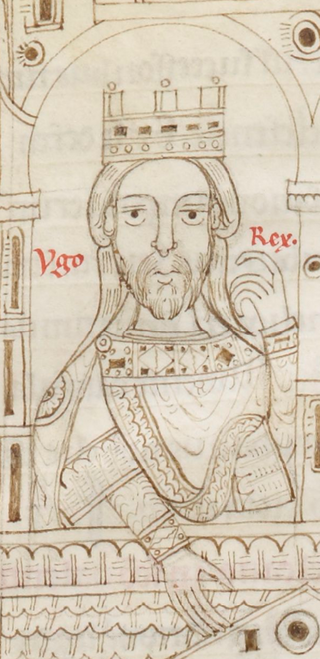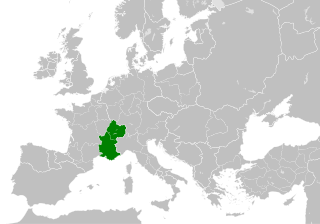
Year 928 (CMXXVIII) was a leap year starting on Tuesday of the Julian calendar.

Rudolph, sometimes called Ralph, was the king of France from 923 until his death in 936. He was elected to succeed his father-in-law, Robert I, and spent much of his reign defending his realm from Viking raids.
Louis the Blind was the king of Provence from 11 January 887, King of Italy from 12 October 900, and briefly Holy Roman Emperor, as Louis III, between 901 and 905. His father was a Bosonid and his mother was a Carolingian. He was blinded after a failed invasion of Italy in 905.
Richard, Duke of Burgundy (858–921), also known as Richard of Autun or Richard the Justiciar, was Count of Autun from 880 and the first Margrave and Duke of Burgundy. He eventually attained suzerainty over all the counties of Burgundy save Mâcon and by 890 he was referred to as dux (duke) and by 900 as marchio (margrave). By 918 he was being called dux Burgundionem or dux Burgundiae, which probably signified less the existence of a unified Burgundian dukedom than feudal suzerainty over a multiplicity of counties in a specific region.

Hugh, known as Hugh of Arles or Hugh of Provence, was the king of Italy from 926 until his death. He belonged to the Bosonid family. During his reign, he empowered his relatives at the expense of the aristocracy and tried to establish a relationship with the Byzantine Empire. He had success in defending the realm from external enemies, but his domestic habits and policies created many internal foes and he was removed from power before his death.

Boso was a Frankish nobleman of the Bosonid family who was related to the Carolingian dynasty and who rose to become King of Lower Burgundy and Provence.

The Kingdom of Lower Burgundy, or Cisjurane Burgundy, was a historical kingdom in what is now southeastern France, so-called because it was lower down the Rhône Valley than Upper Burgundy. It included some of the territory of the Kingdom of Arelat.
Kingdom of Burgundy was a name given to various states located in Western Europe during the Middle Ages. The historical Burgundy correlates with the border area of France, Italy and Switzerland and includes the major modern cities of Geneva and Lyon.

The Kingdom of Burgundy, known from the 12th century as the Kingdom of Arles, also referred to in various context as Arelat, the Kingdom of Arles and Vienne, or Kingdom of Burgundy-Provence, was a realm established in 933 by the merger of the kingdoms of Upper and Lower Burgundy under King Rudolf II. It was incorporated into the Holy Roman Empire in 1033 and from then on was one of the empire's three constituent realms, together with the Kingdom of Germany and the Kingdom of Italy. By the mid-13th century at the latest, however, it had lost its concrete political relevance.

The Kingdom of Upper Burgundy was a Frankish dominion established in 888 by the Welf king Rudolph I of Burgundy on the territory of former Middle Francia. It grew out of the Carolingian margraviate of Transjurane Burgundy southeast of ('beyond') the Jura Mountains together with the adjacent County of Burgundy (Franche-Comté) in the northwest. The adjective 'upper' refers to its location further up the Rhône river, as distinct from Lower Burgundy and also from the Duchy of Burgundy west of the Saône river. Upper Burgundy was reunited with the Kingdom of Lower Burgundy in 933 to form the Kingdom of Burgundy, later known as Kingdom of Arles or Arelat.
Charles-Constantine was a Count of Vienne. His father, Louis the Blind, was King of Provence and Holy Roman Emperor.
This is a list of the counts of Arles.
Boso was a Burgundian nobleman who spent much of his career in Italy, where he became Margrave of Tuscany about 932. He ruled semi-autonomously and was a benefactor of the churches of his region. He lost his office in 936 and probably returned to Burgundy.
Ermengard of Italy, also Ermengarda, Ermengarde, or Irmingard was a queen and regent of Provence. She was the second and only surviving daughter of Louis II, Holy Roman Emperor.
The Bosonids were a dynasty of Carolingian era dukes, counts, bishops and knights descended from Boso the Elder. Eventually they married into the Carolingian dynasty and produced kings and an emperor of the Frankish Empire.

Boson II of Arles was Count of Avignon from 935 and Count of Arles from 949. Around 953, Boso II married Constance, possibly a daughter of the Bivinid Charles Constantine, Count of Vienne, from whom he got two sons: Rotbold II (Roubaud), and William I, Count of Arles and Provence, and then Margrave of Provence. His origin is controversial, even though his life is relatively well known.
Willa of Burgundy was a member of the Elder House of Welf. By birth she was a daughter of Rudolph I of Burgundy, king of Upper Burgundy. Through marriage Boso Willa became countess of Avignon and Arles, and then margravine of Tuscany.